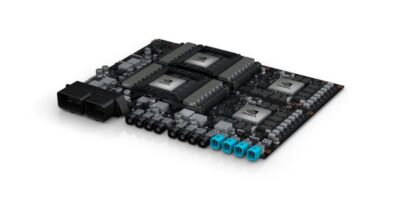Nvidia unveils AI computer paving road for robotaxis at GTC Europe
Munich: Nvidia showed attendees of GTC Europe what it described as the world’s first artificial intelligence (AI) computer designed to drive fully autonomous robotaxis.
Codenamed Pegasus, it extends the Nvidia Drive PX AI computing platform and is designed for Level 5 driverless vehicles. Pegasus delivers over 320 trillion operations per second (TOPS), which is more than 10x its predecessor, Nvidia Drive PX 2.
The Drive PX Pegasus will help make possible a new class of vehicles that can operate without a driver. Robotaxis are fully autonomous vehicles, without steering wheels, pedals or mirrors. Interiors could resemble a living room or office, speculates Nvidia, rather than the cockpit of a vehicle. Robotaxis will arrive on demand to deliver passengers to their destinations. As well as convenience for those who do not use a car enough to warranty buying, or garaging one, this will also bring mobility to the elderly and disabled.
Of the 225 partners developing on the Nvidia Drive PX platform, more than 25 are developing fully autonomous robotaxis using Nvidia Cuda GPUs.
The computational requirements of robotaxis are enormous; perceiving the world through high-resolution, 360-degree surround cameras and lidars, localising the vehicle within centimeter accuracy, tracking vehicles and people around the car, and planning a safe and comfortable path to the destination. All this processing must be done with multiple levels of redundancy to ensure the highest level of safety. The computing demands of driverless vehicles are 50 to 100 times more intensive than the most advanced cars today.
Today, the boot (or trunk) of a robotaxi resembles a small data centres, loaded with racks of computers with server-class Nvidia GPUs running deep learning, computer vision and parallel computing algorithms. Their size, power demands and cost make them impractical for production vehicles.
The vision is that passengers can regain hours on a daily commute that can be spent working or reading, even eating and sleeping. Nvidia also speculates that lives will be saved by vehicles that are never fatigued, impaired or distracted to result in increased road safety, reduced congestion and freeing up valuable land currently used for car parks.
“Creating a fully self-driving car is one of society’s most important endeavours — and one of the most challenging to deliver,” said Jensen Huang, Nvidia founder and CEO. “The breakthrough AI computing performance and efficiency of Pegasus is crucial for the industry to realise this vision.
Virtually all carmakers, transportation as a service companies, as well as startups are using Nvidia AI in the development of Level 5 vehicles, says the company.
Nvdia Drive PX Pegasus is powered by four high-performance AI processors. It couples two of Nvidia’s Xavier SoC processors, featuring an embedded GPU based on the Nvidia Volta architecture. There are also two, next-generation discrete GPUs with hardware created for accelerating deep learning and computer vision algorithms. The system will provide the computational capability for fully autonomous vehicles in a computer the size of a licence plate, drastically reducing energy consumption and cost, says Nvidia.
Pegasus is designed for ASIL D certification, with automotive inputs/outputs, including CAN, Flexray, 16 dedicated high-speed sensor inputs for camera, radar, lidar and ultrasonics, as well as multiple 10Gbit Ethernet connectors. Its combined memory bandwidth exceeds 1Tbyte per second.
The Nvidia Drive PX platform scales from a single mobile processor configuration delivering Level 2+/Level 3 capabilities to a combination of multiple mobile processors and discrete GPUs for full Level 5 capability. Configurations run on a single, open software architecture, allowing car manufacturers and tier 1 suppliers to move from development into production for a wide range of self-driving solutions, Huang cited autoCruise on the highway, to autoChauffeur for point-to-point travel, to Pegasus for a fully autonomous vehicle.
Pegasus will be available to Nvidi automotive partners in the second half of 2018. Nidia DriveWorks software and Nvidia Drive PX 2 configurations are available today for developers working on autonomous vehicles and algorithms.




